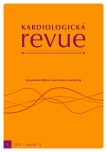-
Medical journals
- Career
Antiarythmic treatment from the point of view of recent recommendations for the treatment of patients with atrial fibrillations
Authors: T. Skála
Authors‘ workplace: I. interní klinika FN Olomouc
Published in: Kardiol Rev Int Med 2011, 13(3): 139-142
Overview
The article deals with the indications and counterindications of individual accessible antiarythmia in the treatment of atrial fibrillation. It discusses the options for pharmacotherapy in the acute and long-term management of patients, options for a control strategy for an adequate ventricular response and efforts to maintain sinus rhythm.
Keywords
atrial fibrillation – antiarythmia – rate-control – rhythm control
Sources
1. European Heart Rhythm Association; European Association for Cardio-Thoracic Surgery. Camm AJ, Kirchhof P, Lip GY et al. Guidelines for the management of atrial fibrillation: The Task Force for the Management of trial Fibrillation of the European Society of Cardiology (ESC). Eur Heart J 2010; 31 : 2369–2429.
2. Kowey PR, Dorian P, Mitchell LB et al. Atrial Arrhythmia Conversion Trial Investigators. Vernakalant hydrochloride for the rapid conversion of atrial fibrillation after cardiac surgery: a randomized, double-blind, placebo-controlled trial. Circ Arrhythm Electrophysiol 2009; 2 : 652–659.
3. Roy D, Pratt CM, Torp-Pedersen C et al. Atrial Arrhythmia Conversion Trial Investigators. Vernakalant hydrochloride for rapid conversion of atrial fibrillation: a phase 3, randomized, placebo-controlled trial. Circulation 2008; 117 : 1518–1525.
4. Camm AJ, Capucci A, Hohnloser S et al. AVRO Investigators. A randomized active-controlled study comparing the efficacy and safety of vernakalant to amiodarone in recent onset atrial fibrillation. J Am Coll Cardiol 2011; 57 : 313–321.
5. Friberg L, Hammar N, Rosenqvist M. Stroke in paroxysmal atrial fibrillation: report from the Stockholm Cohort of Atrial Fibrillation. Eur Heart J 2010; 31 : 967–975.
6. Alboni P, Botto GL, Baldi N et al. Outpatient treatment of ESC Guidelines 2425 recent-onset atrial fibrillation with the ‘pill-in-the-pocket’ approach. N Engl J Med 2004; 351 : 2384–2391.
7. Thrall G, Lane D, Carroll D et al. Quality of life in patients with atrial fibrillation: a systematic review. Am J Med 2006; 119 : 448.e1–e19.
8. Wyse DG, Waldo AL, DiMarco JP et al. Atrial Fibrillation Follow-up Investigation of Rhythm Management (AFFIRM) Investigators. A comparison of rate control and rhythm control in patients with atrial fibrillation. N Engl J Med 2002; 347 : 1825–1833.
9. Van Gelder IC, Hagens VE, Bosker HA et al. Rate Control versus Electrical Cardioversion for Persistent Atrial Fibrillation Study Group. A comparison of rate control and rhythm control in patients with recurrent persistent atrial fibrillation. N Engl J Med 2002; 347 : 1834–1840.
10. Roy D, Talajic M, Nattel S et al. Atrial Fibrillation and Congestive Heart Failure Investigators. Rhythm control versus rate control for atrial fibrillation and heart failure. N Engl J Med 2008; 358 : 2667–2677.
11. Van Gelder IC, Groenveld HF, Crijns HJ et al. RACE II Investigators. Lenient versus strict rate control in patients with atrial fibrillation. N Engl J Med 2010; 362 : 1363–1373.
12. Singh BN, Singh SN, Reda DJ et al. Sotalol Amiodarone Atrial Fibrillation Efficacy Trial (SAFE-T) Investigators. Amiodarone versus sotalol for atrial fibrillation. N Engl J Med 2005; 352 : 1861–1872.
13. Kirchhof P, Franz MR, Bardai A et al. Giant T-U waves precede torsades de pointes in long QT syndrome. A systematic electrocardiographic analysis in patients with acquired and congenital QT prolongation. J Am Coll Cardiol 2009; 54 : 143–149.
14. Haverkamp W, Breithardt G, Camm AJ et al. The potential for QT prolongation and proarrhythmia by non-antiarrhythmic drugs: clinical and regulatory implications. Report on a policy conference of the European Society of Cardiology. Eur Heart J 2000; 21 : 1216–1231.
15. Connolly SJ. Evidence-based analysis of amiodarone efficacy and safety. Circulation 1999; 100 : 2025–2034.
16. Le Heuzey J, De Ferrari GM, Radzik D et al. A short-term, randomized, double-blind, parallel-group study to evaluate the efficacy and safety of dronedarone versus amiodarone in patients with persistent atrial fibrillation: the DIONYSOS study. J Cardiovasc Electrophysiol 2010; 21 : 597–605.
Labels
Paediatric cardiology Internal medicine Cardiac surgery Cardiology
Article was published inCardiology Review

2011 Issue 3-
All articles in this issue
- Antiarythmic treatment from the point of view of recent recommendations for the treatment of patients with atrial fibrillations
- Non-pharmacological treatment from the point of view of recent recommendations for the treatment of patients with atrial fibrillation
- Antithrombotic treatment from the point of view of new guidelines for the management of atrial fibrillation
- Upstream therapy of atrial fibrillation
- Home monitoring of patients with atrial fibrillation
- Home monitoring and implants
- Telemonitoring of blood pressure in patients with arterial hypertension
- Chronic cardiac failure with non-compact cardiomyopathy in a middle-aged woman
- Cardiology Review
- Journal archive
- Current issue
- Online only
- About the journal
Most read in this issue- Antiarythmic treatment from the point of view of recent recommendations for the treatment of patients with atrial fibrillations
- Chronic cardiac failure with non-compact cardiomyopathy in a middle-aged woman
- Antithrombotic treatment from the point of view of new guidelines for the management of atrial fibrillation
- Home monitoring and implants
Login#ADS_BOTTOM_SCRIPTS#Forgotten passwordEnter the email address that you registered with. We will send you instructions on how to set a new password.
- Career

